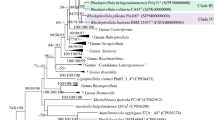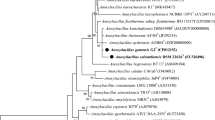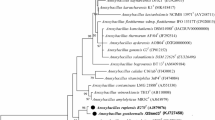Abstract
The genus Algibacter belongs to the family Flavobacteriaceae of the Bacteroidetes, and all members of this genus were isolated from marine environments. Among the Algibacter species, two members, Algibacter lectus KMM 3902T and Algibacter wandonensis WS-MY22T, were isolated from green algae and sediment around a brown algae respectively. The 16S rRNA gene sequences of these two type strains possess 99.4% sequence similarity. In this study, further studies were undertaken to clarify the taxonomic assignments of the two species. Whole-genome sequence analysis showed that the similarities for other phylogenetic markers are also very high (i.e. 99.9% for gyrB, 99.6% for recA and 99.9% for rpoD). Average nucleotide identity, average amino acids identity and digital DNA-DNA hybridization value between A. lectus KMM 3902T and A. wandonensis WS-MY22T are 98.3%, 98.6% and 89.4% respectively, all clearly exceed suggested species delineation thresholds. Furthermore, phylogenetic trees based on sequences of 16S rRNA gene and up-to-date bacterial core gene set (UBCG) consisting of 92 genes provided additional evidence that A. lectus KMM 3902T and A. wandonensis WS-MY22T are very closely related. In addition, a review of their profiles indicated that A. lectus KMM 3902T and A. wandonensis WS-MY22T did not present pronounced differences at phenotypic and chemotaxonomic levels. Based on these evidence, we propose that A. wandonensis should be reclassified as later heterotypic synonyms of A. lectus.


Similar content being viewed by others
References
Nedashkovskaya OI, Kim SB, Han SK, Rhee MS, Lysenko AM, Rohde M, Zhukova NV, Frolova GM, Mikhailov VV, Bae KS (2004) Algibacter lectus gen. nov., sp. nov., a novel member of the family Flavobacteriaceae isolated from green algae. Int J Syst Evol Microbiol 54:1257–1261. https://doi.org/10.1099/ijs.0.02949-0
Yoon JH, Park S (2013) Algibacter wandonensis sp. nov., isolated from sediment around a brown algae (Undaria pinnatifida) reservoir. Int J Syst Evol Microbiol 63:4771–4776. https://doi.org/10.1099/ijs.0.053983-0
Park SC, Hwang YM, Lee JH, Baik KS, Seong CN (2013) Algibacter agarivorans sp. nov. and Algibacter agarilyticus sp. nov., isolated from seawater, reclassification of Marinivirga aestuarii as Algibacter aestuarii comb. nov. and emended description of the genus Algibacter. Int J Syst Evol Microbiol 63:3494–3500. https://doi.org/10.1099/ijs.0.051300-0
Zhang DC, Wu J, Neuner K, Yao J, Margesin R (2015) Algibacter amylolyticus sp. nov., isolated from intertidal sediment. Int J Syst Evol Microbiol 65:1556–1560. https://doi.org/10.1099/ijs.0.000134
Wong SK, Park S, Lee JS, Lee KC, Ogura Y, Hayashi T, Chiura HX, Yoshizawa S, Hamasaki K (2017) Algibacter aquaticus sp. nov., a slightly alkaliphilic marine Flavobacterium isolated from coastal surface water. Int J Syst Evol Microbiol 67:2199–2204. https://doi.org/10.1099/ijsem.0.001924
Park SC, Hwang YM, Choe HN, Baik KS, Kim H, Seong CN (2013) Algibacter aquimarinus sp. nov., isolated from a marine environment, and reclassification of Pontirhabdus pectinivorans as Algibacter pectinivorans comb. nov. Int J Syst Evol Microbiol 63:2038–2042. https://doi.org/10.1099/ijs.0.045815-0
Nedashkovskaya OI, Vancanneyt M, Kim SB, Hoste B, Bae KS (2007) Algibacter mikhailovii sp. nov., a novel marine bacterium of the family Flavobacteriaceae, and emended description of the genus Algibacter. Int J Syst Evol Microbiol 57:2147–2150. https://doi.org/10.1099/ijs.0.65165-0
Park S, Jung YT, Yoon JH (2013) Algibacter miyuki sp. nov. a member of the family Flavobacteriaceae isolated from leachate of a brown algae reservoir. Antonie Van Leeuwenhoek 104:253–260
Liu J, Cai SD, Wang YJ, Wang Q, Zhang DC (2020) Algibacter pacificus sp. nov., isolated from a deep-sea seamount. Int J Syst Evol Microbiol 70:2907–2911. https://doi.org/10.1099/ijsem.0.004119
Sun C, Fu GY, Zhang CY, Hu J, Xu L, Wang RJ, Su Y, Han SB, Yu XY, Cheng H, Zhang XQ, Huo YY, Xu XW, Wu M (2016) Isolation and complete genome sequence of Algibacter alginolytica sp. nov., a novel seaweed-degrading bacteroidetes bacterium with diverse putative polysaccharide utilization loci. Appl Environ Microbiol 82:2975–2987. https://doi.org/10.1128/AEM.00204-16
Wirth JS, Whitman WB (2018) Phylogenomic analyses of a clade within the roseobacter group suggest taxonomic reassignments of species of the genera Aestuariivita, Citreicella, Loktanella, Nautella, Pelagibaca, Ruegeria, Thalassobius, Thiobacimonas and Tropicibacter, and the proposal of six novel genera. Int J Syst Evol Microbiol 68:2393–2411. https://doi.org/10.1099/ijsem.0.002833
Gevers D, Cohan FM, Lawrence JG, Spratt BG, Coenye T, Feil EJ, Stackebrandt E, Van de Peer Y, Vandamme P, Thompson FL, Swings J (2005) Opinion: Re-evaluating prokaryotic species. Nat Rev Microbiol 3:733–739. https://doi.org/10.1038/nrmicro1236
Edgar RC (2004) MUSCLE: a multiple sequence alignment method with reduced time and space complexity. BMC Bioinformatics 5:113. https://doi.org/10.1186/1471-2105-5-113
Kumar S, Stecher G, Li M, Knyaz C, Tamura K (2018) MEGA X: Molecular Evolutionary Genetics Analysis across Computing Platforms. Mol Biol Evol 35:1547–1549. https://doi.org/10.1093/molbev/msy096
Felsenstein J (1981) Evolutionary trees from DNA sequences: a maximum likelihood approach. J Mol Evol 17:368–376
Saitou N, Nei M (1987) The neighbor-joining method: a new method for reconstructing phylogenetic trees. Mol Biol Evol 4:406–425. https://doi.org/10.1093/oxfordjournals.molbev.a040454
Fitch WM (1971) Toward Defining the Course of Evolution: Minimum Change for a Specific Tree Topology. Syst Zool 20:406–416
Richter M, Rosselló-Móra R, Glöckner OF, Peplies J (2016) JSpeciesWS: a web server for prokaryotic species circumscription based on pairwise genome comparison. Bioinformatics 32:929–931. https://doi.org/10.1093/bioinformatics/btv681
Meier-Kolthoff JP, Auch AF, Klenk HP, Göker M (2013) Genome sequence-based species delimitation with confidence intervals and improved distance functions. BMC Bioinformatics 14:60. https://doi.org/10.1186/1471-2105-14-60
Na SI, Kim YO, Yoon SH, Ha SM, Baek I, Chun J (2018) UBCG: Up-to-date bacterial core gene set and pipeline for phylogenomic tree reconstruction. J Microbiol 56:280–285. https://doi.org/10.1007/s12275-018-8014-6
Smibert RM, Krieg NR (1994) Phenotypic characterization. In: Gerhardt P, Murray RGE, Wood WA (eds) Methods for General and Molecular Bacteriology. American Society for Microbiology, Washington, DC, pp 607–654
Vital M, Chai B, Ostman B, Cole J, Konstantinidis KT, Tiedje JM (2015) Gene expression analysis of E. coli strains provides insights into the role of gene regulation in diversification. ISME J 9:1130–1140. https://doi.org/10.1038/ismej.2014.204
Mi ZH, Yu ZC, Su HN, Wang L, Chen XL, Pang X, Qin QL, Xie BB, Zhang XY, Zhou BC, Zhang YZ (2015) Physiological and genetic analyses reveal a mechanistic insight into the multifaceted lifestyles of Pseudoalteromonas sp. SM9913 adapted to the deep-sea sediment. Environ Microbiol 17:3795–3806. https://doi.org/10.1111/1462-2920.12823
Acknowledgements
This study was supported by the grant from the National Natural Science Foundation of China (81801982), the Natural Science Foundation of Shandong Province, China (ZR2019PC021), the Shandong Key Research and Development Plan project (2018GCF118137), the Science and Technology Foundation of Higher Education of Shandong Province (J11LF03) and the Supporting Fund for Teachers' Research of Jining Medical University (JYFC2018KJ007)
Author information
Authors and Affiliations
Contributions
Author A. Liu performed the taxonomic analysis and wrote the manuscript. Authors H. Wang, Y. Y. Yang, Q. J. Xue and X. Z. Li carried out physiology analysis. All authors read and approved the final manuscript.
Corresponding author
Ethics declarations
Conflict of interest
The authors declare that there is no conflict of interest.
Additional information
Publisher's Note
Springer Nature remains neutral with regard to jurisdictional claims in published maps and institutional affiliations.
Supplementary Information
Below is the link to the electronic supplementary material.
Rights and permissions
About this article
Cite this article
Liu, A., Wang, H., Yang, YY. et al. Reclassification of Algibacter wandonensis as a Later Heterotypic Synonym of Algibacter lectus Based on Whole-Genome Sequence Analysis. Curr Microbiol 78, 1034–1038 (2021). https://doi.org/10.1007/s00284-021-02356-5
Received:
Accepted:
Published:
Issue Date:
DOI: https://doi.org/10.1007/s00284-021-02356-5




